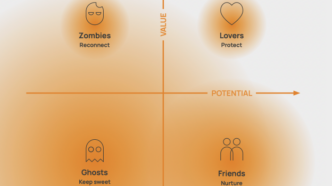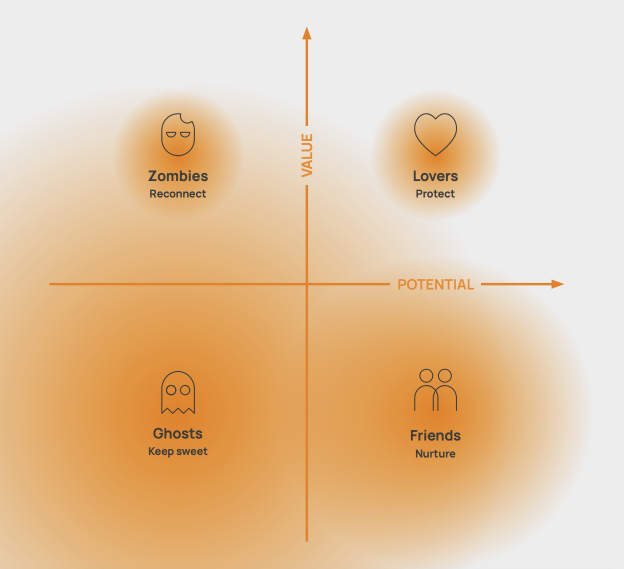

This is a summary of the recently published Retention Economics report, collaboratively written by Kevin Anderson, Consulting Director at Pugpig, and Laura Graham, Media Practice Lead at Manifesto Growth Architects.
For media organizations, 2023 has been the Year of Retention.
At the beginning of the year, research by Minna Technologies found that 37% of people had canceled a subscription in the last six months. Businesses took note and, in the same report, 68% of subscription businesses cited retention as their top priority. And for good reason – increasing customer retention by 5% can increase profits by at least 25% and up to 95%, according to research by Bain Capital.
However, until recently, focus has been on churn management over retention.
Media organizations have traditionally created dedicated teams whose sole focus is to stop subscribers canceling their contracts, often through discounting or by offering additional benefits. This not only risks the spiral of ever reducing subscriber ARPU and can result in a large proportion never paying full price, but it also dilutes the value proposition and chips away at brand equity. Short-term KPIs (usually monthly net churn) have been prioritized over longer-term lifetime value, because of an addiction to volume; these measures of success drive knee jerk reactions, and do not reflect the mix of audiences or how they are monetized.
Relationship Management – the new retention strategy
To manage the range of relationships that media businesses have with their audiences, the entire organization – including marketing, product, editorial, advertising and circulation – needs to be mobilized, not just a winback team. This approach will help organizations maximize customer lifetime value, not just of subscribers, but also from audiences across the engagement spectrum.
In short: shifting from funnel management (which goes one way, and tries to prevent cancellations) to constant engagement loops that aim to prevent audiences from leaving the ecosystem (even at a lower ARPU).
In practice, this means that media businesses will need to maintain and nurture audience relationships at every level of engagement, from lightly engaged casual users to highly engaged known users and to users whose relationship with you might have cooled. It means being comfortable with the fact that not everyone will be a subscriber, and that retention efforts will be different depending on the type of relationship that an audience member wants to have.
> To read next: 10 ways to combat subscription churn
Four cohorts for relationship management
The report divides audiences into four cohorts based on current and potential value:
- Ghosts – the large group of loosely connected, unknown users. Single visits, unknowns can make up to 90% of a publisher’s audience, Madeleine White, editor-in-chief of the Audiencers recently told Poool’s London conference.
The goal with Ghosts: Keep Them Sweet with an experience that mirrors how the brand is portrayed to the outside world. In other words, continue to pique their curiosity.
- Friends – a smaller, but growing group of known, registered users who haven’t taken the plunge to become subscribers but who also have a lot of potential for the business
The goal with Friends: nurture the relationship. How this is achieved should be aligned to how they became a Friend in the first place: entice engaged social users to sign up to a newsletter; promote other products to registered users; or encourage event goers to bring someone along with them next time.
- Lovers – these are the closest and deepest relationships. They are a small but mighty cohort, because they are passionate about the brand and its proposition, driving the most significant levels of ARPU
The goal with Lovers: protect the relationship. The easy trap here is to assume that only subscribers can be Lovers; but they’re not mutually exclusive. ARPU is generated from ongoing interactions with a brand, across multiple platforms, regardless of whether they are behind a paywall or not. Therefore, fail to protect your non subscribing Lovers at your peril.
- Zombies – you had a relationship with them once, but it has since cooled.
The goal with Zombies: an engagement strategy to reconnect. Being transparent and making it easy for them to walk away actually improves the likelihood of reconnecting in the long run, if CLTV is prioritized over shorter-term KPIs. The moral of the story is: i) Put in the effort to negate audiences becoming Zombies in the first place, but ii). Do not burn bridges by trying to hang on to a relationship that is not working for either party
While the North Star goal for most media organizations remains subscriber growth, there is revenue to be earned from all of these cohorts.
Tactics for maximizing the value of each cohort
To maximize revenue across these cohorts, organizations need to offer a range of free and paid propositions, and those propositions should change over time depending on economic conditions and the publisher’s business.
There is no playbook when determining which propositions should be available to whom; subscriptions are of course paid-for; social is 99% of the time free to access; but with podcasts, newsletters and events, things are more nuanced. However, they are all assets in the game of relationship management – we have 5 key principles for how to use them:
1. Set expectations from the get-go
It is all about building the right, ongoing relationships for your audiences. At the core of any retention strategy are great products, and that requires empathy and a sense of what creates value for different audience segments. The result will be increased retention and higher revenues.
2. The honeymoon will be sweet, but it does come to an end
News UK data shows it lasts about a week, in which readers either develop a habit or never do. For mobile users, the honeymoon is even shorter. Publishers have 48 hours to engage users, with 57% of users opening an app only a handful of times before deciding to delete it, according to push provider Airship. Publishers need to track what features and elements of their proposition are used most, when and how frequently and correlate that to engagement and propensity to churn.
3. Everyone wants to feel special
With so much content, the challenge is to stand out and how your proposition fits into the daily lives of your customers. Customers are no longer satisfied with one-size-fits all products, including content. According to research from Salesforce, 66% of consumers expect companies to understand their unique needs, and 52% expect personalized offers. Data about technology, behavior, psychographics and behaviors is the foundation of delivering passive personalization. And personalization can deliver a five to 10 times increase in ROI, according to Harvard Business Review.
4. Offer something that’s difficult to live without
As with any relationship, the more frequently you can connect with customers, the more embedded the relationship becomes, and therefore the higher the likelihood they will stay. Publishers like the New York Times have built a bundle of products that connect with their audiences multiple times a day. It allows them to upsell to increase ARPU, and they have found that multi-product users churn 40% less than news-only subscribers.
5. Great experiences are the core of great relationships
Delivering great experiences need not be overly complex. It primarily involves getting closer to your users, gaining a deeper understanding of their needs, and taking proactive steps to serve them better.
That’s just a taster of what is in the report, you can download the full report here from the Media Collective – Pugpig, Manifesto Growth Architects, InDigital Marketing and Piano.












